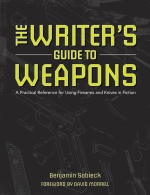I was reading a thriller last night where a character popped open a switchblade to slit the throat of someone pinned in a car wreck. (Took a lot of guts to do that, chump.) There’s nothing wrong with that passage, but it made me wonder if writers and readers know what it is that makes a knife a switchblade.
Switchblades’ Two Key Features
When most people picture a switchblade, they imagine something like this Shutterstock pic:
That’s a particular style of knife called an Italian stiletto, and it’s a cosmetic thing. That a knife looks like that doesn’t make it a switchblade.
By federal definition under the 1958 Switchblade Act, a switchblade sports two important features:
1) It contains a blade concealed inside a handle biased to come out of the handle.
2) The blade is released when a button, switch or other device on the handle is pressed. (You can see the big brass button on the handle in the pic above.)
If a knife doesn’t have both of those features, it’s not a switchblade. I italicized those bits because they separate switchblades from assisted openers. More on those later.
Switchblades: Mostly Dead
 In 1958, for reasons I go into in the guide, switchblades were prohibited by federal law. However, this only applied to interstate commerce. States could still determine their own switchblade laws, although most opted to restrict them. That means switchblades are, as Billy Crystal in The Princess Bride would say, only mostly dead across the U.S.
In 1958, for reasons I go into in the guide, switchblades were prohibited by federal law. However, this only applied to interstate commerce. States could still determine their own switchblade laws, although most opted to restrict them. That means switchblades are, as Billy Crystal in The Princess Bride would say, only mostly dead across the U.S.
Some states, such as New Hampshire, and municipalities allow civilian switchblade commerce and possession. Those new models are generally limited to short or custom runs. Most switchblades in circulation elsewhere are antiques.
More common are “automatic knives.” That’s the term for modern, manufactured switchblades. They’re sold to military and law enforcement organizations. They look nothing like Italian stilettos. They’re more in line with typical folding knives, with the exception that they contain those two points mentioned above. It follows that military and law enforcement characters would have no problem obtaining automatic knives. It’s still accurate to call them “switchblades,” but writing “automatic knives” instead will lend a nice touch.
It’s Time to Phase Out Switchblades
Although they’re popular in fiction, I think it’s time to phase switchblades out for characters without access to automatic knives (i.e. not law enforcement or military characters). From a practical standpoint, they fail during hard use and don’t always open as the springs wear out. Laws limit their availability to the average Joe and lowlife, leaving a pool of antiques in circulation to withstand the rigors of crime fiction. Switchblades’ association with crime and fiction is left over from mid-20th century pop culture. Times – and technology – have moved on.
Assisted opening knives are the better option for fiction’s protagonists and assorted bad guys. They function almost identically to switchblades without the legal restrictions. They gained popularity in the late ’90s and were exempted in 2009 from the 1958 Switchblade Act.
Get the Book
 The Writer’s Guide to Weapons: A Practical Reference for Using Firearms and Knives in Fiction (Writer’s Digest Books) comes with everything but the ammo. Pick up a print or digital copy from these fine retailers:
The Writer’s Guide to Weapons: A Practical Reference for Using Firearms and Knives in Fiction (Writer’s Digest Books) comes with everything but the ammo. Pick up a print or digital copy from these fine retailers:

Dear Ben,
thanks for the lesson, and update, on knife-types. I belong to an older generation and remember the classic, Italian stiletto switchblade (lengthy, as legal was for loser-kids) from my own childhood. It was a kind of good luck charm against a priest more focused on carnal than spiritual. 😉
Germany, in a streak of humor and business acumen, offers plenty of assisted-opening knives. While those are not a full replacement for fighting-knives or survival-knives, as another of your article reflects so well, they can serve two types of villain PLUS serving as an easily carried tool.
For villains the fact that cheap steel in assisted-opening blade-form starts around a price of 8€ makes it common among lowlifes, scumbags, and criminals. By type it is the frenzy-prone toughs, made famous due youth of Islam, and the stealth-killer in the streetwise levels (below full army training). Core-problem is cheap steel loses its edge, and material-wearing-out happens quickly.
Goodbye!
LikeLiked by 1 person
Thanks for the comment, Andre. Aren’t all knives that are able to open with one hand illegal in Germany? Your story reminded me of that. I could be wrong, though.
You’re right, though, that the price of a knife has more to do with the likelihood of it being used in a crime than the characteristics of the knife itself. I think that’s something lost in the discussion here in the States about knife laws.
LikeLike
Pingback: A stiletto is stealthy, but is it healthy? – Brian the Muse!
Pingback: A stiletto is stealthy, but is it healthy?